Commercial Salmon Fisheries
Southeast Alaska & Yakutat Research: McDonald Lake Sockeye Salmon
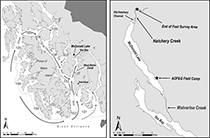
Figure 1. — Click for more Info
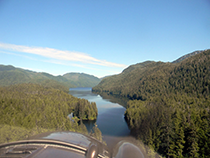
Figure 2. — Click for more Info

Figure 3. — Click for more Info
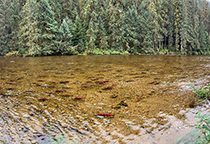
Figure 4. — Click for more Info
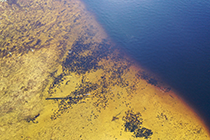
Figure 5. — Click for more Info

Figure 6. — Click for more Info
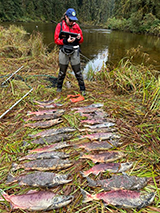
Figure 7. — Click for more Info
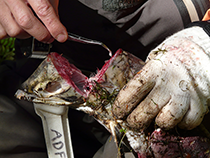
Figure 8. — Click for more Info

Figure 9. — Click for more Info

Figure 10. — Click for more Info

Figure 11. — Click for more Info
Introduction
McDonald Lake, located on the mainland near the north end of west Behm Canal (Figure 1), has been an important contributor to southern Southeast Alaska commercial fisheries for over a century. McDonald Lake is an incredibly productive system for sockeye salmon, producing one of the largest sockeye salmon runs in southern Southeast Alaska. In good years the sockeye salmon run size rivals or exceeds that of large mainland systems like the Stikine and Taku Rivers. Like most other major sockeye salmon systems in the region, the McDonald Lake run has a history of commercial exploitation and hatchery operation during the late 1800s and early 1900s. Runs were thought to exceed 100,000 sockeye salmon in 1909 and 1911, and more than 200,000 in 1910. More recently, total run sizes averaged 250,000 fish in the 1980s and 1990s before declining to approximately 80,000 fish since 2001. Sockeye salmon escapements have averaged approximately 77,000 fish since 1980, with a maximum escapement of 179,000 fish in 1993. The current sustainable escapement goal for McDonald Lake is 55,000–120,000 sockeye salmon.
McDonald Lake has been the focus of numerous research and enhancement efforts going back over 100 years. Operation of a hatchery at the head of the lake, adjacent to the primary spawning tributary (now known as Hatchery Creek), began in 1905 and continued until 1932. More recently, a fertilization project was conducted from 1982 to 2004, at which time a wide variety of water chemistry, phytoplankton, zooplankton, and juvenile sockeye salmon sampling was conducted. Sockeye salmon escapements were estimated with an adult counting weir operated on the outlet stream from 1981 to 1984, by mark-recapture from 2005 to 2007, and by regular foot survey efforts since the late 1970s. Information on the harvest of McDonald Lake sockeye salmon has been obtained from marine tagging studies (1982–1983), coded wire tagging studies (1985; 1989–1991), sampling fisheries for thermal-marked stocked McDonald Lake sockeye salmon (2011–2014), and through genetic studies (2007–2009; 2014–present).
In 2009, the Alaska Board of Fisheries classified McDonald Lake sockeye salmon as a stock of management concern based on recommendations by ADF&G, and an action plan intended to reduce commercial harvests of McDonald Lake sockeye salmon through time and area closures in nearby fisheries was implemented. McDonald Lake sockeye salmon escapement estimates were within the escapement goal range from 2010 through 2012 and the run was delisted as a stock of management concern at the Alaska Board of Fisheries meeting in 2012. From 2013 to 2017, however, escapements again fell below the sustainable escapement goal range in 4 out of 5 consecutive years, and the stock was again classified as a stock of management concern at the 2018 Alaska Board of Fisheries meeting. The escapement goal was met in 2023 for the first time since 2015 (Figure 3). Management actions outlined in the action plan have effectively reduced harvest rates on this stock and they will remain in place until runs improve and escapement goals are met more consistently.
Location
McDonald Lake is located on mainland Southeast Alaska, on the northeast side of Cleveland Peninsula, 70 km north of Ketchikan (Figures 1 and 2). The lake is approximately 7.1 kilometers long and 0.8 kilometers across at its widest point, with a mean depth of 46 meters, and a maximum depth of 110 meters. The outlet stream, Wolverine Creek, flows south 2.4 km to Yes Bay, in West Behm Canal. The primary spawning stream, Hatchery Creek, flows southwest 9.6 km to the head of the lake and has a barrier to anadromous migration approximately 1.5 km upstream of the lake. The foot surveys conducted to estimate escapement are conducted on the 1.5 km of Hatchery Creek from just upstream of the mouth to a location just downstream of the barrier falls and includes the old hatchery side channel on the lower section of the creek (Figure 1).
Escapement
McDonald Lake sockeye salmon spawn from late August to mid-October, and peak spawning activity typically occurs in the second half of September. The McDonald Lake sockeye salmon escapement is estimated by conducting foot surveys at the primary spawning grounds on Hatchery Creek at the upper end of the lake. The stream has many characteristics that make it excellent for conducting foot surveys, including shallow depth over nearly the entire survey length, relatively narrow stream width, and contrasting pale granite substrate, which provides excellent conditions for counting fish (Figures 4 and 5). Each year, the peak survey count is determined from 3 standardized foot surveys of the spawning grounds conducted on approximately 10 September, 20 September, and 28 September, although additional foot surveys may be conducted on sampling trips to collect otolith and scale samples (Figures 6–8). The peak count of sockeye salmon is then expanded to an estimate of total escapement based on 6 years of matched peak foot survey counts with total escapement estimates from weir counts and mark-recapture studies. Additional years of mark-recapture studies are planned for 2024 through 2026, which will help refine the calibrations used to expand foot surveys to estimates of total escapement.
Additional sockeye salmon sampling occurs at the spawning grounds on Hatchery Creek where ADF&G collects scale samples and/or otolith samples from carcasses to determine the age composition of the escapement (Figures 6–8). We also collect matched length data from each fish sampled, which helps us monitor trends in fish size at age.
Commercial Harvest and Total Run
McDonald Lake sockeye salmon contribute substantially to commercial net fisheries in Sumner and Clarence Straits and are also harvested in the Yes Bay personal-use fishery near the outlet stream. Commercial fishery harvest estimates for McDonald Lake sockeye salmon are calculated using genetic stock identification (GSI) analysis. Sockeye salmon tissue samples used for GIS are collected in seafood processing plants, buying stations, and on tenders in Southeast Alaska by the ADF&G Commercial Fisheries Port Sampling Program. The recoveries are segregated into district, gear type, and statistical weeks, and the proportions of each sample assigned to McDonald Lake sockeye salmon can be applied to the total catch in the same strata (district, gear type, and statistical week), and the sum of all gear types and weeks is the total estimated commercial catch of McDonald Lake sockeye salmon. The total commercial catch paired with the escapement estimated with the weir-calibrated foot surveys allows the calculation of the total run (escapement plus harvest) and harvest rate (harvest divided by the total run). Harvest rates vary from year to year, and also by district, gear type and week of harvest.
Hydroacoustic Fry Surveys
During the fall, a hydroacoustic survey is conducted to estimate the number of sockeye salmon fry rearing in the lake (Figures 9–11). Juvenile sockeye salmon rearing in lakes typically undergo what is known as a diel vertical migration, where they move shallower in the evening and deeper during the daytime. We conduct the survey at night when the juvenile sockeye salmon are generally in the upper 20–30 meters of the water column by towing a sonar system across 20 individual transects over the length of the lake. The estimates of juvenile abundance allow us to compare relative reproductive success of spawning escapements through time.
Selected Publications
- McDonald Lake sockeye salmon stock assessment, 2021–2023 (Regional Operational Plan). (PDF)
- McDonald Lake Sockeye Salmon Stock Status and Action Plan, 2018. (PDF)
- Distribution and Run Timing of Stocked McDonald Lake Sockeye Salmon, 2011–2014. (PDF)
- Genetic Stock Identification of McDonald Lake Sockeye Salmon in Selected Southeast Alaska Fisheries, 2007–2009. (PDF)
- McDonald Lake Sockeye Salmon Stock Status and Escapement Goal Recommendations, 2008. (PDF)
- Sockeye Salmon Mark-Recapture and Radio Telemetry Studies at McDonald Lake in 2007. (PDF)
- Sockeye Salmon Mark-Recapture and Radio Telemetry Studies at McDonald Lake, 2005–2006. (PDF)
- McDonald Lake: Stock Status and Escapement Goal Recommendations (2005). (PDF)
